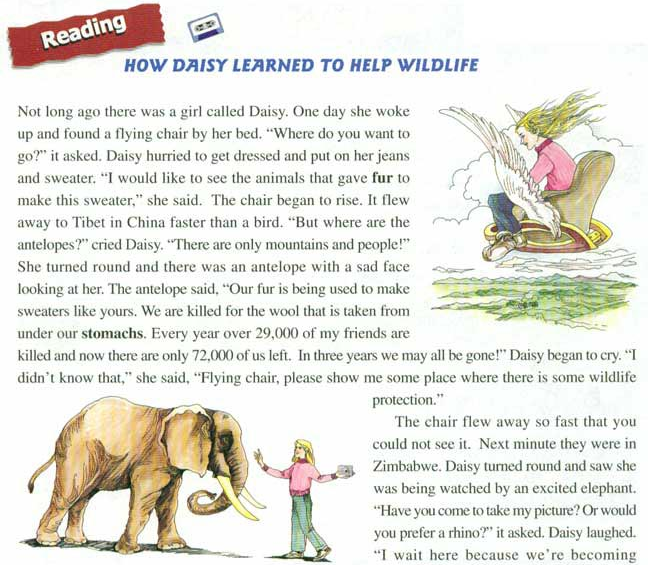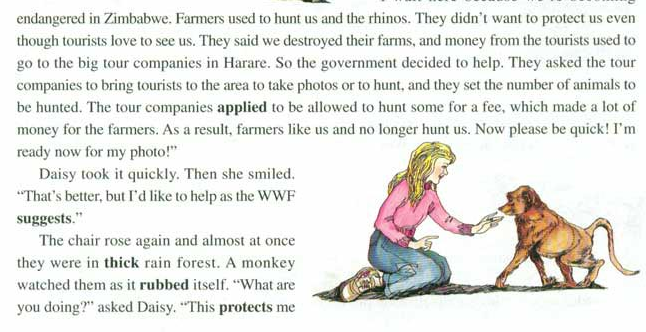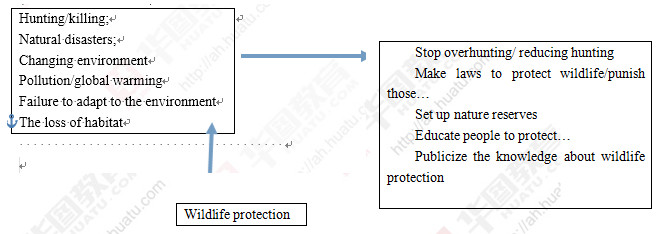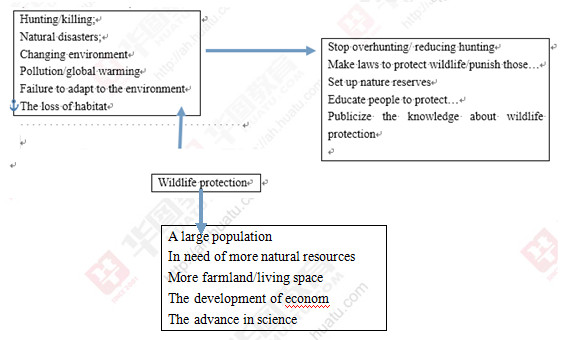2017安徽教师招聘考试高中英语阅读教学读后设计
2016-11-12 18:50 安徽教师招考网 来源:安徽华图 
安徽教师招考网同步安徽华图考试动态信息:2017安徽教师招聘考试高中英语阅读教学读后设计。更多关于安徽教师招聘考试,安徽教师招考网,英语阅读教学读后设计,安徽华图的信息的内容,请关注安徽教师招聘考试网,以及教师考试团(jiaoshitest)认证号和交流群( )获取更多招考信息和备考资料。
)获取更多招考信息和备考资料。
高中英语阅读教学读后设计案例分析及提升
---以How Daisy Learned to Helped Wildlife为例
吕媛媛
阅读课是招教考试高中英语的常规课型,很多学员也能知道大体的步骤是分为导入、读前、读中、读后、小结以及作业这几个基本环节进行的。对于读后,大多数老师都停留在复述课文、小组讨论这样的概念,读后环节的设置相当于语言产出,如果没有用心的设计,很难帮助目标学习对象完成学习目标。本文将结合一篇高中英语课文,从不同的角度进行读后活动设计,希望给大家提供借鉴。
How Daisy Learned to Helped Wildlife是人教版必修2 unit 4的一则通话故事。描述了小女孩Daisy通过一次奇妙的旅行,明白了野生动物保护的重要性。文中所用的词汇体现的核心话题是wildlife protection,这也是高中英语一个重要话题。(本文给出两篇完整案例,方便后续学习)



课例一:
Learning goals:
1. Students will be able to know some words and expressions about wildlife protection.
2. Students will be able to summarize the three aspects that Daisy learned about wildlife protection by analyzing the text structure and understanding the detailed information of the text
3. Students will be able to share their knowledge about wildlife information.
4. Students will learn how to use some topic-related vocabularies to organize a short passage on a topic-centered situation(the structure of the writing passage)
Procedures:
Step 1: Greetings
Cheer the whole class up by greeting the students.
Step 2: Lead-in
Free talk with the students about their favorite animals and the reasons why they like them. Classify the animals into three categories: living animals, extinct animals and endangered animals.
(Introduce the topic and focus on the understanding of some topic-related words and others that may cause obstacles during the process of reading: antelope, Tibet, Zimbabwe, species, wildlife, die out, endangered)
Step 3: Pre-reading
A brief summary of the story by explaining the title and introducing the girl Daisy.
Step 4: General reading
1. Answer the question: what happened to Daisy one day?
2. Analyze the structure of the text. (a trip is usually organized in the order of space and time)
3. Skim the passage and finish the first three columns of the following chart quickly.
Daisy’s stops on her tripThe animal(s) she metHer feeling
Tibet(Para.1)An antelopeFelt sad (Daisy cried)
Zimbabwe(Para.2)An elephantFelt happy (in relief/burst into laughter)
A thick rainforest (para. 3)A monkeyFelt amazed
What Daisy has learned from the trip (Para. 4)So much about how to protect wildlife
Step 5: Detailed reading
1. Skim the passage one paragraph after another and discover the causes of Daisy’s feelings at each stop. (根据Daisy’s feelings, causes of her feelings, topic conclusion as writing guide作为精读线索)
2. Make a summary of the structure of the reading text: the present situation of the wildlife—the importance of wildlife protection—the importance of habitat protection.
Step 6: post-reading activities
Task 1: Teamwork for extended views about wildlife protection
Work in groups of four and work on the views about wildlife protection.
Task 2: writing
Work in groups of four. Supposing you were a poor roebuck, due to your dangerous situation, you feel the urge to write a letter to the WWF to call for help for your family.
案例说明:
上述教学设计采用了“导入—文体特征分析—初步阅读(文章篇章结构)--深层次阅读(教师提问、细节理解、语言赏析)--学生讨论—语言拓展性活动”这一基本教学模式。存在几个问题:
1. 导入呈现的单词和操练环节的核心单词不一致,建议前面的讲解少些(只是为了扫除阅读障碍),操练的核心单词需要多一些穿插的铺垫。
2. 读后讨论活动,任务切口太大,需要给予适当引导;
3. 写作任务综合性强,缺乏相关的语言铺垫。
课例改进:
Learning goals:
1. Students will be able to use some words and expressions about wildlife protection in topic-related activities. (wildlife, in the wild, decrease, be in danger of dying out, endangered species, without mercy, in relief, feel relieved, habitat, nature reserve/ protection zones, protect from, live in peace/harmony with)
2. Students will be able to summarize the three aspects that Daisy learned about wild life protection by analyzing the text structure and understanding the detailed information of the text.
3. Students will be able to share their knowledge about wildlife protection.
4. Students will be able to carry out an imaginary interview on a topic-centered situation by using some topic-related vocabularies (in accordance with the subtopics of the reading).
课前板书:amazing/amazed; wildlife; in the wild; in nature; be in danger of; endangered species; protect, protection; decrease; be in relief=feel relieved
课前准备:播放有关野生动物和自然的影片(配音乐),以渲染课堂气氛并激发学生的学校情绪,激活主题(wildlife protection)意识。
Teaching procedures:
Step 1: Greeting and Presentation
Teacher: The beauty of nature is really amazing. It really makes us amazed. Right? Hello, boys and girls. Nice to meet you. I’m Fancy. I’m from a place famous for yellow wine, a place full of water and mountains and of course animals.
I love animals. I love cats and dogs, because they can make good friends. I love dolphins, because they are lovely and can play wonderful ball games. I love all kinds of birds, because they are colorful. Do you like animals?
Students: Yes.
Teacher: Fantastic! Same interest! So can you tell me the animal you like best?
Students: (one by one) I like dogs, because they can keep me company and comfort me when I am lonely.
I like pandas because they’re cute and lovely.
I like monkeys because they are clever.
Teacher: Yes, I agree with you. They are among the most intelligent animals.
I like elephants because they are big and …
Teacher: powerful, strong, right?
Teacher: thank you for your wonderful opinions. In this world, there are so many animals. Cats and dogs are kept at home. They are not wildlife. Wildlife grows in the wild or in nature. Animals like dinosaurs, we can only see them in the pictures or museums, for they have died out, or they are extinct. Some wildlife like golden monkeys, pandas and Tibetan Antelopes, their number is decreasing. They are in danger of dying out. In this case, we call them endangered species (kind). These animals need our help. Luckily, many people in this world are fond of animals, just like you and me.
Step 2: pre-reading
A brief introduction of the main character and the story.
Teacher: And also a little girl called Daisy. She had always longed to help the endangered species of wild life. (呈现ppt) Here “long to do sth.” Means…
Students: … “Want to do sth. for a long time.”
Teacher: Yeah, now let’s have a look at the title of the reading: “How Daisy Learned to Help Wildlife.” This is a story, right?
Students: Yes.
Teacher: For a story, we can read its first paragraph fast and discover the background of the story.
Step 3: Fast reading
Teacher: Then read the first paragraph fast and try to find the answer to the question: “What happened to Daisy one day?” That’s also the background of the story.
Student: One day, she woke up and found a flying carpet.
Teacher: A flying carpet, a carpet that can fly. They are magical. That means it can take Daisy to different places in a very short time, right? So in this way, she went on a magical journey.
Then, where had she been? Now skim the whole text and pick out the key information about her journey: the places she went, the animals she saw and her different feelings.
(学生快速阅读,完成表格,教师穿插讲解relieved, amazed)
Fast reading
Daisy’s stopsanimalsHer feeling
Tibet (Para. 1)An antelopeSad
Zimbabwe (Para. 2)An elephantHappy/relieved
A rainforest (Para. 3)A monkeyAmazed
Back home (Para. 4)Learned so much about wildlife protection & WWF
Teacher: From this chart, we know the structure of the whole text. We also know that Daisy had different feelings at different stops. Then what caused her to be sad, happy and amazed? This time we’ll go deep into the first three paragraphs for more detailed information.
Step 4: Detailed reading
Teacher: Read the first paragraph carefully and get the answer to the questions: “what happened to the Tibetan antelopes?” and “What is the cause of Daisy’s sad feelings?” Ready? Get started.
Student: The antelopes are being killed.
Teacher: For what?
Student: For the wool beneath the stomach and its fur.
Teacher: Thank you. They were killed so their number is decreasing. In this case, we can say… (课件呈现)
Student: Now the antelopes have become an endangered species because of killing.
Teacher: Terrific! You know, antelopes are a good example of endangered species of wildlife. Well, now can you summarize the main idea of the 1st paragraph?
Student 1: The first paragraph mainly tells us about what’s happening to some endangered species of wildlife.
Student 2: It mainly tells us some species of wildlife are endangered.
Teacher: Correct answers. We can also use the phrase “the present situation of some endangered species of wildlife”, do you think so? (课件呈现)
Detailed reading for information
FeelingcausesExtended views
sadThe antelopes are being killed for the wood… and the fur…
As a result, now the antelope have become an endangered species because of killing/hunting.Why is wildlife endangered?
.killing/overhunting
. …
Main idea: the present situation of some endangered species
Students: Yes.
Teacher: Just now, we know that many wildlife animals are in danger of dying out just because of killing or over-hunting. Then besides this, any other reasons why they are endangered? You’ll have some minutes to discuss with your partner, and then report your views to the whole class, OK?
Student 1: Because of natural disasters such as earthquakes, floods and so on.
Student 2: They are killed because our environment has changed.
Student 3: All kinds of pollution.
Student 4: The rise of the global temperature, or we call it global warming, may cause many wildlife animals to die.
Student 5: Some wildlife animals cannot adapt themselves to the environment.
Student 6: The loss of habitats.
Teacher: Big applause for your wonderful creative views.
(边说边书写如下板书)

Teacher: Leaving Tibet, Daisy raveled to Zimbabwe. There the sight of an elephant made her feel relieved. Then what caused the change of her feeling? Let’s go through the 2nd paragraph carefully to find: “what did the farmers do to the elephants in the past? Who helped them? And now?”
(带着问题梳理加工,理解段落意思)
Teacher: Well, time is up. Now can you tell me what the farmers used to do to the elephant?
Student: In the past, they hunted them without mercy.
Teacher: What does the phrase “without mercy” mean here?
Student: Without pity.
Teacher: Good explanation. Then who helped them?
Student: The government.
Teacher: How?
Student: By allowing the tourists to hunt a certain number of elephants if they paid the farmers.
Student: With the money, the farmers will reduce hunting.
Teacher: That’s right. So the government helped the elephant just by limiting or reducing hunting, or by stopping overhunting, got it?
Student: Yes.
Teacher: Then what’s the result of the government’s doing so? Let’s appreciate one sentence in this paragraph:
“Daisy found she was being watched by an elephant. ‘Have you come to take my photo?’”
What’s your feeling after you read the sentence?
Student: Funny. An elephant can speak just like a person.
Student: It makes me happy. It seems they live a happy life in Zimbabwe.
Teacher: Both are right. So this sentence describe a happy scene. Beyond the happy scene, what can we infer?
Student: The elephants get along well with the human beings.
Teacher: Human beings live in peace/ harmony with wildlife animals. (课件呈现)
Now can you summarize the main idea of this paragraph?
Student: The result of wildlife protection.
Student: The importance of wildlife protection. (课件表格如下)
Detailed reading for information
FeeingcausesExtended views
Relieved1. In the past, farmers hunted them without mercy.
2. Later, the government helped to protect them by reducing hunting/stop overhunting.Can you think out other protective measures?
. reduce hunting/ stop overhunting
Main idea: the importance of wildlife protection
Teacher: Well done! Really good summary. Since wildlife protection is of great importance, we should take any measures to protect them. Then besides the measures mentioned in the text, please work out some other protective measures together with partner.
Student: The government can make some wildlife protection laws.
Student: If some people still don’t stop killing wildlife, make laws to punish them.
Student: Plant more trees for the wildlife.
Student: Set up nature reserves for the wildlife.
Teacher: Educate people about wildlife protection knowledge/publicize the knowledge about wildlife protection.)
Student: Stop polluting the air, water and the land around us and the wildlife.
Teacher: Let’s have a look at the job you’ve done together, quite reasonable advice, isn’t it?
(板书如下)

Teacher: We have finished our trip in Zimbabwe with Daisy. Our next stop is a rainforest. The monkey she saw there really amazed her. What was the monkey doing? Read about Daisy’s experience in the rainforest and show us the answer to this question.
Teacher: OK? Any volunteers can show us your answers to the question above?
Student: The monkey was rubbing itself.
Teacher: What’s the purpose of doing so?
Teacher: With what?
Teacher: Where was the drug taken from?
Student: The drug was taken from an insect living in the rainforest.
Teacher: The sight amazed Daisy, so she had a chat with the monkey. During the conversation, the monkey said, “No rainforest, no animals, no drugs.” How do you understand the sentence?
Student: Rainforest is the living place of the monkey, it is also the base for their living.
Student: without rainforest, there would be no animals and no drugs.
Teacher: Yes, that’s the deep meaning of the line. We know “rainforest is the living place, or just as the student called it just now, habitat of many wildlife animals”, right? So, this paragraph mainly tells us “the importance of wildlife protection also lies in the importance of ..”
Student: the importance of protecting habitat of the wildlife. (课件呈现)
Detailed reading for information
FeeingcausesExtended views
amazedA monkey was rubbing itself to protect if from mosquitoes with a drug taken from an insect living in the rainforest.Why are wildlife’s habitats being destroyed?
Main idea: the importance of habitat (living place) protection
Teacher: That’s it. Why should we protect them?
Student: because they are being destroyed.
Teacher: Then why are they being destroyed? You’ll have time to exchange your views with your partner before reporting it to the whole class.
Student: Because of the development of economy, people need more natural resources.
Student: There are more and more people in the world and they need more land, space, so they cut down the forest.
Student: The progress in science needs more from the rainforest
Teacher: Thank you. Today you’ve really done an excellent job. That really amazed me.
(此段针对文章细节的提问值得借鉴,尤其是在挖课文深度的时候)

(此处对高中英语课文的处理方式值得借鉴,采用问题分解和追问的方式,先是细节理解,再是一系列理解性语言输出活动,如:语言深层含义推断、段落主旨大意概括、相关话题拓展讨论。)
Teacher: By now, we’ve finished the journey with Daisy and returned home. Through this journey, Daisy leanred so much about wildlife protection. Let’s have a revision about the subtopics of wildlife protection--- the main idea of each paragraph. (课件呈现)
Revision of the subtopics of wildlife protection
The present situation of endangered wildlife
The importance of protective measures
The importance of habitat protection
What Daisy leanred on her magical journey
Years later, Daisy has become a reporter for WWF… One day…
(本环节回顾整篇文章结构和内容,引申到最后的综合性语言输出活动)
Step 5: Integrated post-reading activity
Teacher: From this journey, Daisy also knew that there was a wildlife protection organization called WWF. Years later, Daisy fulfilled her dream. She has become a reporter for WWF. Then one day, Daisy met the antelope again. But this time, he is not sad, and alone. He has his own wife and babies. They live happily together.
Task: Suppose you were Daisy, a journalist for WWF, just make an interview with the antelope. The interview is to cover: (1)his past situation; (2)the causes of his past dangerous situation; (3) the measures government has taken to help them; (4) his present life.
Task direction: Work in groups of four. Share your ideas and try to use some words and expressions we’ve learned in this class. Carry out the imaginary interview and two students will be invited to act them out.
Step 6: Summary
Teacher: At the end of the class, let’s enjoy some pictures with all our heart. The first picture, some cranes are walking leisurely on the wetland. The second one, a cute koala is sound asleep on the trees. And the third, two leopards show affection towards each other.
So beautiful picturs, just remember: wildlife animals have their own life. Treat them just like our own babies. Love them. Show concern for them. Ever distturb their peaceful life, that’s also the way to protect ourselves.
Step 7: Homework
1.Finish writing the interview for a newspaper.
2.Search the Internet and find more information about WWF.
——相关阅读——
招考信息--2021安徽教师招聘公告|职位表|历年分数线
面试相关--2021安徽教师成绩查询|排名|资格复审|面试公告
备考资料--2021安徽教师招聘历年试题|备考资料
推荐图书--2021安徽教师招聘图书网课|笔试课程
辅导课程--2021教师资格笔试网络课程|图书资料
历年考情--2021安徽教师资格考试公告|教师资格认定公告
以上是2017安徽教师招聘考试高中英语阅读教学读后设计的全部内容,更多资讯请继续查看:安徽教师招考网、安徽省中小学教师招聘考试网、安徽教师资格证考试网。
本文【2017安徽教师招聘考试高中英语阅读教学读后设计】来源于安徽华图,具体最终信息请以安徽华图为准!
(编辑:吴俊)






